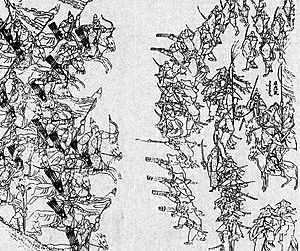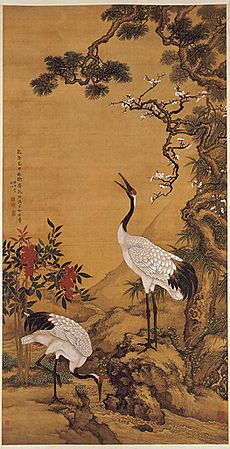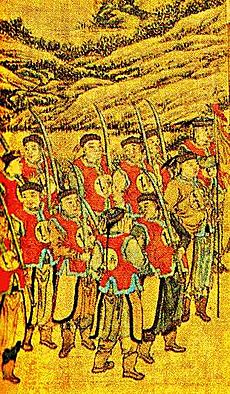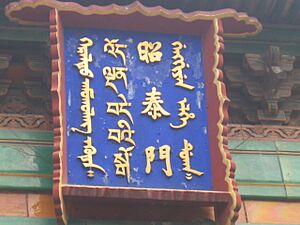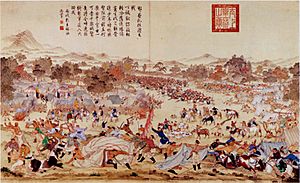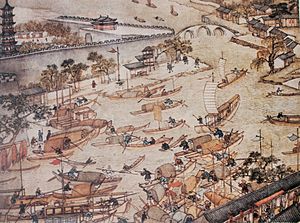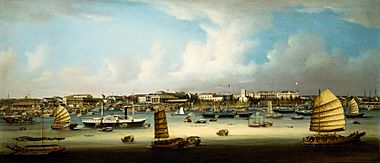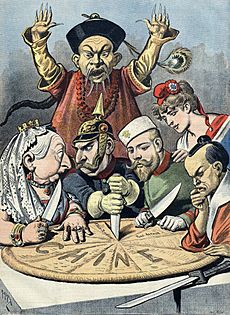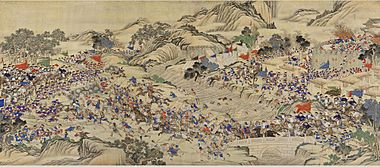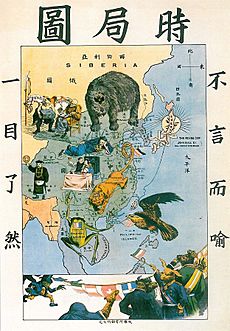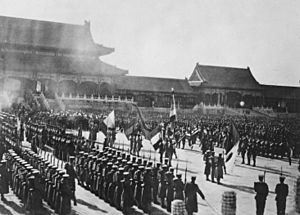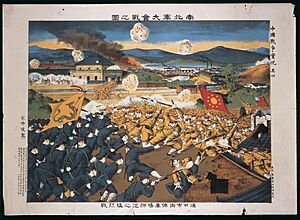History of the Qing dynasty facts for kids
The history of the Qing dynasty is the story of China's last imperial family. It began in 1636 when a Manchu leader named Hong Taiji announced the start of the Qing dynasty. However, most people consider 1644 as the true beginning, because that's when the Qing took control of Beijing, the capital of the previous Ming dynasty. The Qing dynasty ruled China for a long time, until 1912, when the last emperor, Puyi, stepped down because of the 1911 Revolution.
The Qing dynasty became incredibly powerful, expanding China's territory more than ever before. But in its later years, it faced big challenges from Western countries and Japan. The Qing leaders struggled to deal with these foreign powers, which eventually led to the dynasty's downfall. This period of instability also set the stage for a time in China known as the Warlord Era.
Even though he didn't officially start the Qing dynasty, a leader named Nurhaci laid the groundwork. He united different Jurchen tribes, created a strong military system called the Eight Banners, and started taking land from the Ming dynasty. His son, Hong Taiji, then officially named the dynasty "Qing." He prepared the way for the conquest of the Ming, but he died before it happened.
In 1644, peasant rebels led by Li Zicheng captured Beijing. But a Ming general, Wu Sangui, opened the gates of the Shanhai Pass to the Qing armies. The Qing, led by Prince Dorgon, defeated the rebels and took over Beijing. They also made a controversial rule: all Han Chinese men had to wear their hair in a queue, a Manchu hairstyle.
Under the Shunzhi Emperor, the Qing conquered most of China. The Kangxi Emperor took the throne in 1662 and ruled for 61 years. His reign was a time of great prosperity, known as the High Qing era. He put down a major rebellion and settled border conflicts. His son, the Yongzheng Emperor, was a skilled reformer. Along with his son, the Qianlong Emperor, the Qing military expanded the empire to its largest size ever.
However, the huge empire and its economy began to struggle. Corruption became a big problem, with officials like Heshen stealing money. This led to widespread hunger. The Jiaqing Emperor tried to stop corruption and put down rebellions. His successor, the Daoguang Emperor, tried to stop the opium trade, which led to the First Opium War with the British. China lost, and the Treaty of Nanjing forced China to give Hong Kong Island to Britain and open several ports to foreign trade. This was the first of many "unequal treaties."
More conflicts with foreign powers led to the Second Opium War in 1856. At the same time, the Taiping Rebellion broke out in 1850. Led by Hong Xiuquan, this rebellion was one of the bloodiest conflicts in history, causing 20 to 30 million deaths. Even though the Qing eventually won, the rebellion severely weakened the dynasty.
After the rebellion, Empress Dowager Cixi became the most powerful figure from 1861 to 1908. She oversaw some reforms. But by the turn of the century, the Boxer Rebellion showed how unhappy people were. This led to an international army invading China. Cixi sided with the rebels but was defeated. Her death in 1908 left China in deep trouble. The emperor, Puyi, was just a toddler. A powerful general, Yuan Shikai, eventually forced Puyi to step down in 1912, ending the Qing dynasty and over 2,000 years of imperial rule in China.
Contents
How the Manchu State Formed
The Qing dynasty was not founded by the Han Chinese, who are the main ethnic group in China. Instead, it was started by the Manchus. These people were descendants of farmers called the Jurchen, who lived in what is now northeastern China.
Nurhaci: Uniting the Tribes
The Manchu state began with Nurhaci, a leader of a small Jurchen tribe in the early 1600s. Nurhaci was once a supporter of the Ming emperors. But he started fighting other tribes and eventually united them. By 1616, he was strong enough to declare himself the Khan of the "Great Jin" kingdom. This name was a nod to an earlier Jurchen Jin dynasty.
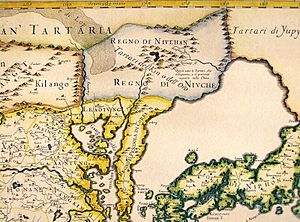
Two years later, Nurhaci openly challenged the Ming dynasty. He moved his capital to bigger cities he captured from the Ming, like Liaoyang and Shenyang. Nurhaci also organized the Jurchens into a military and administrative system called the Eight Banners. This system helped turn the different Jurchen tribes into a single, strong nation. He also created a written Manchu script.
The Manchus were not numerous enough to conquer all of China on their own. So, they gained strength by defeating and bringing in Mongols. More importantly, they added many Han Chinese people to their Eight Banners. These Han Chinese soldiers played a huge role in the Qing conquest of China.
Hong Taiji: Building the Empire
Nurhaci's military success ended in 1626 when he was defeated by a Ming general. He died a few months later, and his son, Hong Taiji, became the new leader. Hong Taiji faced challenges early on, including another defeat by the Ming.
To improve his army, Hong Taiji created his own artillery unit in 1634. He used Chinese soldiers who could make cannons like the Europeans. In 1635, he officially named his people "Manchu." In 1636, Hong Taiji changed his state's name from "Great Jin" to "Great Qing" and declared himself Emperor. This showed his ambition to rule all of China. He then invaded Korea again.
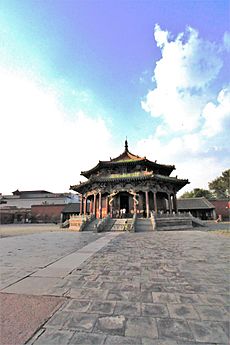
Hong Taiji also set up a basic government system based on the Ming model. He created six ministries to handle things like finance and military. Many Han Chinese officials worked in this new government. Hong Taiji also changed how the Manchus treated their Han Chinese subjects. He wanted to attract more Han Chinese to join them, so he treated them better than his father had. This policy helped increase his army and encouraged more Ming subjects to surrender.

Taking Control of China
Hong Taiji died suddenly in 1643. The Qing state didn't have a clear way to choose the next leader. After some debate, Hong Taiji's five-year-old son, Fulin, became the Shunzhi Emperor. Prince Dorgon, Hong Taiji's half-brother, became the regent, meaning he ruled for the young emperor.

Meanwhile, the Ming dynasty was falling apart. In April 1644, rebels led by Li Zicheng captured Beijing. The last Ming emperor took his own life. Li Zicheng then marched to fight Wu Sangui, a Ming general guarding the Shanhai Pass on the Great Wall. Wu Sangui, caught between the rebels and the Qing, decided to join forces with the Qing. Together, Wu and Dorgon defeated Li Zicheng's rebels.
The Qing armies captured Beijing on June 6. The Shunzhi Emperor was declared the "Son of Heaven" (Emperor) on October 30. The Qing presented themselves as the rightful successors to the Ming. However, it took another 17 years to conquer the rest of China, fighting against Ming loyalists and other rebels.
The Qing were smart about gaining support. They encouraged Ming soldiers to join them by promising to value their skills. Many Han Chinese soldiers joined the Eight Banners, gaining special rights. These Han Chinese soldiers, along with Manchu and Mongol forces, helped conquer China.
To encourage peace between ethnic groups, a rule in 1648 allowed Han Chinese men to marry Manchu women. However, this policy was later changed.
Dorgon, as regent, made many important decisions. He chose Beijing as the capital, which helped stabilize the new government. He also kept most Ming officials in their jobs. However, he also issued a controversial order in July 1645: all adult Han Chinese men had to shave the front of their heads and wear the Manchu queue hairstyle. Refusing meant death. This rule was a test of loyalty for the Manchus, but for the Han Chinese, it was a great humiliation and led to strong resistance and violence.
Dorgon died suddenly in 1650, and the Shunzhi Emperor began to rule on his own, though his mother, Empress Dowager Xiaozhuang, helped him. The Shunzhi Emperor died young in 1661 from smallpox. His third son, Xuanye, became the Kangxi Emperor.
Kangxi Emperor: A Golden Age

The Kangxi Emperor ruled for 61 years, the longest of any Chinese emperor. His reign is seen as the start of the "High Qing," a time when the dynasty was at its strongest in terms of society, economy, and military. Kangxi became emperor when he was only eight years old. To prevent anyone from becoming too powerful, his father appointed four senior ministers to help him rule. Kangxi, when he was 15, cleverly took full control by tricking and imprisoning the most dominant minister, Oboi.
The early Manchu rulers used two main ways to keep their power stable. First, they adopted the government systems and neo-Confucian culture from earlier Chinese dynasties. They used the examination system to allow Han Chinese to become officials. Kangxi also supported Confucian learning.
Second, their Manchu identity helped them connect with Mongol, Tibetan, and Muslim people in the empire. Qing emperors used different titles for these groups, showing respect for their cultures. For example, they were seen as "Chinese Emperor" by Tibetans and "Bogda Khan" by Mongols. Kangxi also welcomed Jesuit missionaries to his court. These missionaries served as experts in areas like weapons, math, and astronomy.
However, controlling such a vast empire was hard. The Qing relied on Chinese soldiers who had surrendered from the Ming dynasty. Three of these surrendered Ming generals were given large territories in Southern China to govern. These were Wu Sangui, Shang Kexi, and Geng Jingzhong.
Over time, these three generals became very powerful and independent. In 1673, Shang Kexi asked to retire and wanted his son to take over. Kangxi allowed his retirement but refused to let his son inherit the territory. The other two generals then also asked to retire, hoping to test Kangxi. But the young emperor accepted their requests, ordering all three territories to be returned to the crown.
This led to the Revolt of the Three Feudatories. Wu Sangui and the others rebelled. The war lasted eight years. At one point, the rebels controlled land as far north as the Yangtze River. But Kangxi managed to unite his forces and counterattack. By 1681, the Qing government had regained control of southern China.
During this rebellion, the Han Chinese Green Standard Army (made of former Ming soldiers) performed better than the Manchu Bannermen in some areas. Kangxi used Han Chinese generals and soldiers to fight other Han Chinese rebels, especially in difficult mountain terrain.
To expand the empire's control in Central Asia, Kangxi personally led military campaigns against the Dzungars in Outer Mongolia. He successfully drove them out and added these regions to the empire. In 1683, Qing forces took control of Formosa (Taiwan) from Zheng Keshuang, whose family had used it as a base against the Qing. Kangxi also settled border disputes with Russia through the Treaty of Nerchinsk in 1689, which kept the border peaceful for a long time.
By the end of the 17th century, China was very confident and politically strong, a peak not seen since the Ming dynasty.
Yongzheng and Qianlong: Peak of Power
The reigns of the Yongzheng Emperor (ruled 1723–1735) and his son, the Qianlong Emperor (ruled 1735–1796), were the height of Qing power. During this time, the Qing Empire covered a massive area of over 13 million square kilometers. However, by the end of Qianlong's reign, there were already signs of problems.
After the Kangxi Emperor died in 1722, his fourth son, Prince Yong, became the Yongzheng Emperor. He was 45 and felt a strong need to fix the problems that had grown during his father's later years. He was known for being strict but very capable.
Yongzheng quickly got to work. He promoted traditional Confucian ideas and cracked down on groups he saw as unorthodox. In 1723, he outlawed Christianity and sent missionaries away, though some stayed in the capital. He also strengthened government control. He expanded a system where officials sent secret reports directly to the emperor, and he created a small Grand Council of personal advisors, which became the emperor's main cabinet.

Yongzheng also tried to fix the empire's financial problems. He pushed to collect land taxes more strictly. The extra money was used to pay officials better and fund local projects like irrigation and schools. While these reforms worked well in the north, they faced resistance in the south.
Yongzheng also dealt with foreign issues. He signed the Treaty of Kyakhta (1727) with Russia, which helped stabilize relations. He also fought campaigns against the Dzungars and local tribes in the southwest. These wars were expensive but helped the emperor control the military.
The Yongzheng Emperor died in 1735. His 24-year-old son became the Qianlong Emperor. Qianlong personally led military campaigns near Xinjiang and Mongolia, putting down revolts and expanding control over Tibet.
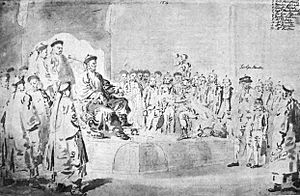
Qianlong also started big cultural projects, like putting together the Complete Library of the Four Treasuries. This was the largest collection of books in Chinese history. However, Qianlong also used "Literary Inquisition" to silence people who criticized the dynasty.
Despite the outward success, Qianlong's later years saw a rise in corruption and neglect. In 1795, he announced he would step down in favor of his son, Prince Jia, out of respect for his grandfather, Kangxi. Prince Jia became the Jiaqing Emperor in 1796. But for three years, Qianlong still made all the decisions as the "emperor emeritus."
After Qianlong died in 1799, the Jiaqing Emperor took full control. At this time, the Qing Empire faced internal problems, especially the large-scale White Lotus (1796–1804) and Miao (1795–1806) rebellions. The imperial treasury was also empty. Jiaqing tried to bring China back to its earlier prosperity, but the economy declined, partly because of a lot of silver leaving the country to pay for opium smuggled from British India.
China also faced a growing problem of too many people during this period. The population had grown from 100 million to 300 million in the 18th century, partly due to new crops like potatoes and peanuts. All available farmland was being used up. The emperor tried to stop Han Chinese from settling in Manchuria, which was considered the Manchu homeland, but many still moved there.
In 1796, the White Lotus Society started an open rebellion, blaming Qing officials for their problems. Other rebellions followed, but the White Lotus Rebellion finally ended in 1804 after many years of fighting.
Rebellions and Outside Pressure

At the start of the Qing dynasty, China was the most powerful country in East Asia. It had a system where neighboring countries sent gifts to show respect. However, in the 18th century, European empires grew stronger, with advanced economies and technology. The Qing tried to control trade by setting up the Canton System in 1756, which limited foreign trade to the city of Guangzhou.
In 1793, the British sent a delegation led by Lord George Macartney to China. They wanted to open up more trade and have equal relations. But the Qianlong Emperor didn't see trade as very important. He told Macartney that China had everything it needed.
Europeans wanted Chinese goods like silk and tea, but China didn't need much from Europe. So, Europeans paid with silver. To balance this, the British East India Company greatly increased its production of opium in India and smuggled it into China. The Daoguang Emperor was worried about the silver leaving China and the harm opium was causing. He ordered Lin Zexu to stop the opium trade. Lin confiscated opium in 1839, which led Britain to send a military force.
The First Opium War showed how outdated China's military was. The Qing navy was no match for the modern British Royal Navy. British soldiers, with their advanced weapons, easily defeated Qing forces on land. China's defeat in 1842 was a huge humiliation. The Treaty of Nanjing forced China to pay for the war, open five ports to Western trade, and give Hong Kong Island to Britain. This treaty exposed the Qing government's weaknesses and led to more rebellions.
The Taiping Rebellion (1850–1864) was the biggest threat to the Qing. Led by Hong Xiuquan, who claimed to be Jesus Christ's brother, the rebels aimed to create a new kingdom. This civil war was incredibly bloody, causing 20 to 30 million deaths. Even though the Qing eventually won, with help from British and French troops, the rebellion severely weakened the dynasty. Other rebellions by Muslims and Miao people also broke out.
Western powers, still unhappy with the Treaty of Nanjing, pushed for more. In 1856, an incident involving a ship called the Arrow led to the Second Opium War. In 1858, the Xianfeng Emperor was forced to sign the Treaty of Tientsin, which was very insulting to China. It demanded that Chinese documents be written in English and allowed British warships free access to Chinese rivers.
When the British and French marched on Beijing in 1860, the emperor fled. The foreign forces looted and burned the Old Summer Palace. Prince Gong, the emperor's half-brother, was forced to sign the Convention of Beijing. The humiliated emperor died the next year.
Efforts to Modernize and Their Challenges
Despite these problems, the dynasty tried to recover. Chinese generals like Zuo Zongtang helped put down rebellions. When the Tongzhi Emperor became emperor at age five in 1861, officials rallied around him in what was called the Tongzhi Restoration. Their goal was to adopt Western military technology to protect traditional Chinese values. They created China's first foreign affairs ministry, the Zongli Yamen, and modernized the army and navy. This was part of the Self-Strengthening Movement.
However, China continued to lose control of its outer territories. Russia took large parts of the Northeast in 1860. France expanded its control in Indochina, leading to the Sino-French War (1884–1885), which China lost. This war ended with China recognizing French control over Vietnam.
Tensions also grew with Japan over Korea. The First Sino-Japanese War in 1895 was another humiliating military defeat for China. The Treaty of Shimonoseki forced China to recognize Korean independence and give Taiwan and the Pescadores islands to Japan.
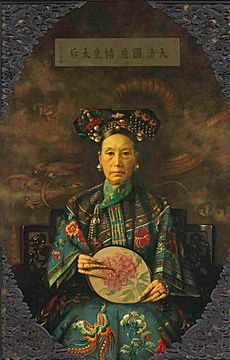
These years saw Empress Dowager Cixi become very influential. She was a concubine to the Xianfeng Emperor and came to power in 1861 when her young son, the Tongzhi Emperor, took the throne. She became a regent, ruling for the child emperor. After her son died, her nephew, the Guangxu Emperor, became emperor, and Cixi continued to rule as regent.
In 1898, Germany used the murder of two missionaries as an excuse to take control of Jiaozhou Bay. This led to a "scramble for concessions," where other foreign powers also demanded special rights and territories in China.
In response to these defeats, the Guangxu Emperor started the Hundred Days' Reform in 1898. He issued many new laws to reorganize the government and school system. But the Empress Dowager Cixi quickly stopped these reforms, arrested some reformers, and took full control of policy again. However, the idea of reform had taken root.
Boxer Rebellion: Fighting Foreign Influence
The Boxer Rebellion (1899–1901) was a violent uprising against foreign influence, especially Christian missionaries and their Chinese followers. It mainly affected northern China around Beijing. The Boxers were a peasant movement that was anti-Christian and anti-foreign. Empress Dowager Cixi was pleased when the Boxers attacked foreigners who were building railroads, taking China's resources, and converting Chinese people to a foreign religion.
In June 1900, the Boxers invaded Beijing and killed many foreigners and Chinese Christians. The Cixi government was unable to stop them. Diplomats, foreign civilians, and soldiers retreated to the legation quarter and were trapped for 55 days. An Eight-Nation Alliance of foreign powers sent 20,000 troops to rescue them. The Boxers and government forces were larger in number but poorly organized and armed. They were quickly defeated, and the imperial court had to flee.
The Chinese government was forced to pay huge amounts of money to the Alliance over many years and make many more concessions. Some people saw the Boxers as uncivilized and superstitious, while others praised them as patriotic anti-imperialists. The reforms that followed this rebellion helped lead to the end of Manchu rule and the creation of a modern nation.
Reform, Revolution, and the End of an Era
By the early 1900s, there was widespread unrest in China. To deal with these problems, Empress Dowager Cixi issued an order in 1901 calling for reforms. This began the "New Policies" era. These reforms included creating a national education system and ending the imperial examinations in 1905, which had been used to select officials for centuries.
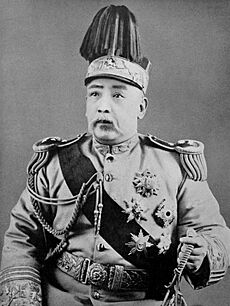
The Guangxu Emperor died on November 14, 1908, and Cixi died the next day. There were rumors that they were poisoned. Puyi, the two-year-old son of Zaifeng, Prince Chun, became the new emperor, with Zaifeng as regent. Zaifeng soon dismissed General Yuan Shikai from his powerful positions. In 1911, Zaifeng created a cabinet, but it was mostly made up of imperial family members, which angered many people who wanted a more modern government.
The Wuchang Uprising on October 10, 1911, was a success. By November, 14 of China's 22 provinces had rejected Qing rule. This led to the creation of a new central government, the Republic of China, in Nanjing, with Sun Yat-sen as its temporary leader.
Seeing the desperate situation, the Qing government brought Yuan Shikai back to military power. He took control of his army to fight the revolution. After becoming Prime Minister, Yuan Shikai even asked for Zaifeng to be removed from the regency. Yuan Shikai became a dictator, and the Manchu dynasty lost all its power.
Premier Yuan Shikai and Sun Yat-sen decided that a war would be too costly. Sun Yat-sen wanted a republic, and he agreed to let Yuan become the first President of the Republic of China.
On February 12, 1912, Empress Dowager Longyu issued an imperial order for the child emperor Puyi to step down. This officially ended over 2,000 years of Imperial China and began a long period of instability. Some Qing loyalists tried to bring back the monarchy, but they failed. In July 1917, there was a brief attempt to restore the Qing dynasty, but it was quickly stopped by republican troops. Puyi was allowed to live in the Forbidden city until 1924. In the 1930s, Japan invaded Northeast China and set up a puppet state called Manchukuo, with Puyi as its emperor. But Manchukuo fell in 1945 after the Soviet Union invaded.
Images for kids
-
A Chinese paddle-wheel driven ship from a Qing encyclopedia published in 1726.


